Breeding Amano shrimp is a fascinating journey that involves understanding their unique life cycle and providing the conditions for survival. The process starts with a healthy diet for egg production, followed by molting and mating.
The female then carries the eggs until they develop into larvae. However, unlike most freshwater shrimp, Amano shrimp larvae require brackish water to survive, making their breeding process quite challenging.
Hello, fellow Shrimp Keepers! I’m here to share my personal journey of breeding Amano shrimp, a task that has been both challenging and rewarding. Over the past few years, I’ve spent countless months observing these fascinating creatures, tweaking their environment, and learning from my mistakes.
In the past, I’ve seen the joy of eggs being produced, the anticipation of waiting for them to develop, and the disappointment when things didn’t go as planned. But through it all, I’ve gained a wealth of knowledge and a deep appreciation for these incredible invertebrates.
Breeding Amano shrimp is a journey that starts with understanding them, they are not just another shrimp species; they have unique needs and behaviors that make them stand out in the shrimp world.
One of the most crucial aspects of their life cycle is their diet, which plays a significant role in egg production. A well-fed Amano shrimp is a happy shrimp, and a happy shrimp is more likely to breed successfully.
| Parameter | American Units | European Units |
|---|---|---|
| Temperature | 70-80°F | 21-27°C |
| pH | 6.5-7.5 | 6.5-7.5 |
| General Hardness (GH) | 4-8 dGH | 70-140 ppm |
| Carbonate Hardness (KH) | 1-4 dKH | 18-70 ppm |
| Total Dissolved Solids (TDS) | 150-200 ppm | 150-200 ppm |
| Ammonia, Nitrite, Nitrate | 0 ppm | 0 mg/l |
| Salinity (for larvae) | 1.012-1.020 specific gravity | 17-35 ppt |
Please note that these are general guidelines and the specific needs of your Amano shrimp may vary depending on their individual health, age, and other factors.
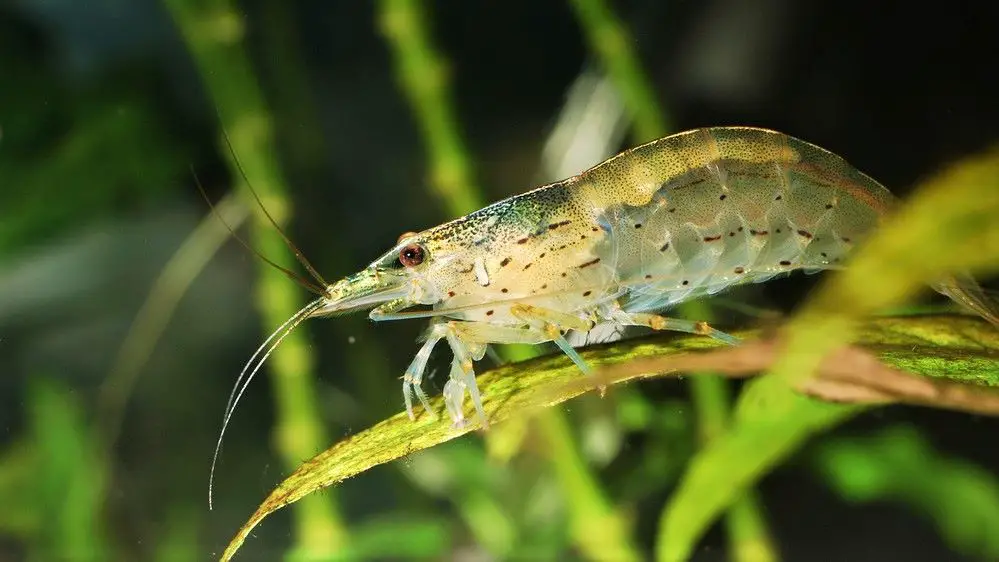
Life Cycle of Amano Shrimp
The life cycle of Amano shrimp, scientifically known as Caridina multidentata, is a captivating process that sets them apart from many other freshwater shrimp species. It’s a journey that takes us from egg to adult, with a fascinating detour into brackish waters.
The life cycle begins when a female Amano shrimp carries fertilized eggs under her abdomen after a successful molt and mating session. This state is often referred to as being “berried” due to the appearance of the eggs resembling small berries.
The female Amano shrimp is a dedicated mother, constantly fanning the eggs with her swimmerets to provide oxygen and prevent fungal growth.
After about 4-6 weeks, these eggs hatch into larvae. Unlike many other shrimp species, Amano shrimp larvae go through a planktonic stage where they are free-swimming and do not resemble the adult form. This stage is where things get tricky.
The larvae require brackish water conditions to survive and grow, necessitating a move from their freshwater home to a saltier environment. This adaptation is believed to be a survival strategy, reducing competition and predation for the vulnerable larvae.
In the brackish water, the larvae go through several stages of development, molting and growing, until they metamorphose into a form that begins to resemble the adult shrimp. This process can take anywhere from 30 to 45 days, depending on conditions such as temperature and salinity.
Once the transformation is complete, the young shrimp are ready to transition back to freshwater, just like their parents. They continue to grow, molt, and eventually reach sexual maturity, ready to start the cycle anew.
Breeding Amano shrimp in captivity requires a keen understanding of this unique life cycle and the ability to provide the right conditions at each stage. It’s a challenging endeavor, but for those who embark on it, it offers a rewarding glimpse into the fascinating life of these incredible creatures.
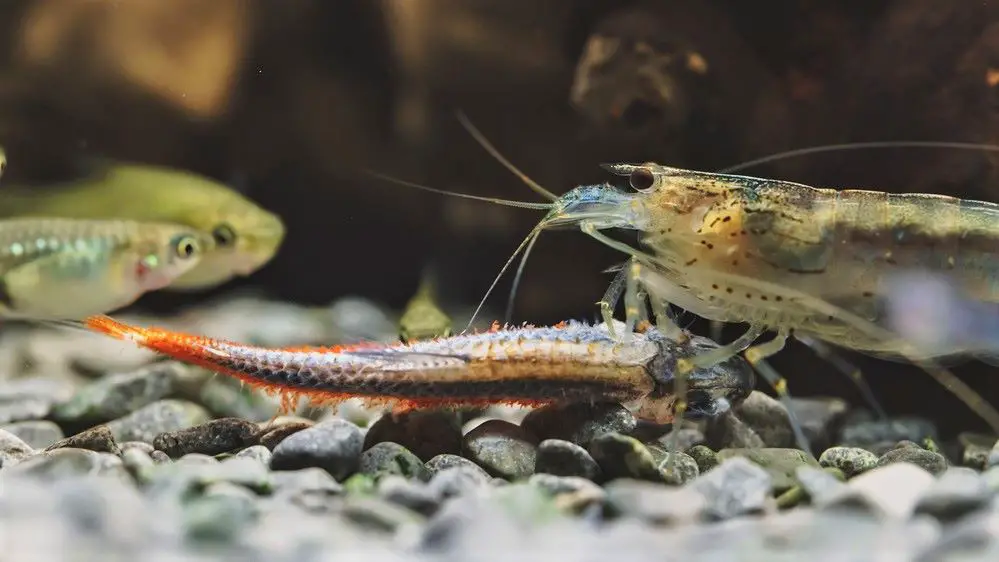
Importance of Diet in Amano Shrimp Breeding
The diet of Amano shrimp plays a pivotal role in their breeding process. Just like us humans, these little crustaceans need a balanced and nutritious diet to thrive and reproduce successfully. Let’s dive into the details of what Amano shrimp eat and why it’s so crucial for their breeding.
Amano shrimp are omnivores, meaning they eat both plant and animal matter. In the wild, they are known as excellent algae eaters, keeping aquatic environments clean by munching on various types of algae. This natural diet is rich in essential nutrients that contribute to their overall health and reproductive capabilities.
In a captive environment, Amano shrimp will happily continue their algae-eating habits. However, depending on the size of your tank and the number of shrimp, the naturally occurring algae might not be enough to sustain them. This is where supplemental feeding comes into play.
A well-rounded diet for Amano shrimp can include algae wafers, blanched vegetables (like zucchini, spinach, and peas), and high-quality shrimp pellets. These foods provide a range of nutrients, including proteins, carbohydrates, vitamins, and minerals, all of which contribute to the shrimp’s health and fertility.
Protein, in particular, plays a crucial role in egg production. A diet rich in high-quality protein sources can enhance the number of eggs a female produces and improve their viability.
Carbohydrates and fats provide the energy shrimp need for daily activities, including foraging, mating, and carrying eggs. Vitamins and minerals, on the other hand, contribute to various physiological functions, including molting, which is a critical process in shrimp reproduction.
A balanced and nutritious diet is key to successful Amano shrimp breeding. By providing a variety of foods and ensuring they get all the nutrients they need, you can enhance their breeding potential and contribute to the overall health of your shrimp population.
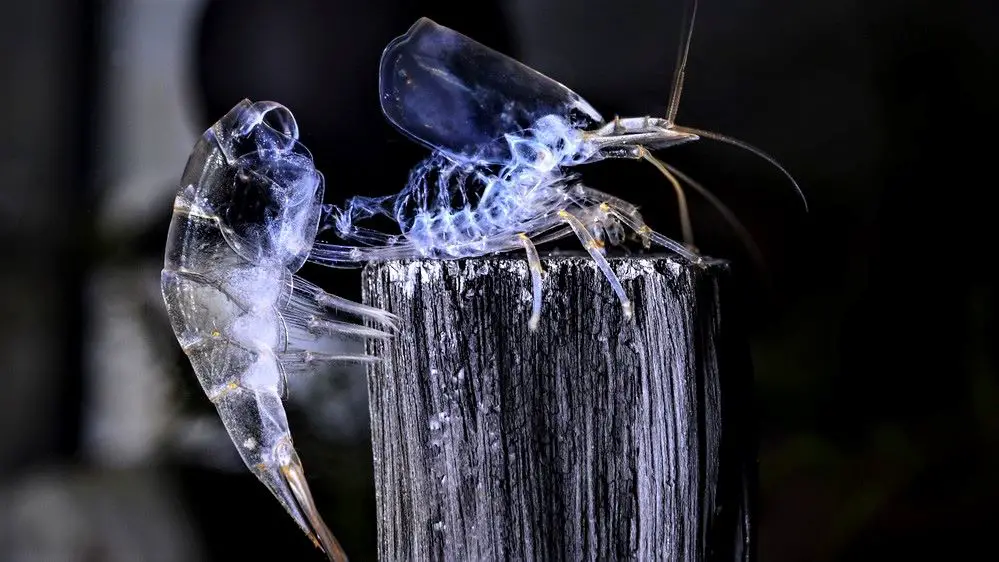
Process of Molting and Mating in Amano Shrimp
Molting and mating are two interconnected processes in the life of an Amano shrimp, both playing a crucial role in their reproduction. Let’s delve into these fascinating phenomena and understand their significance in the Amano shrimp’s breeding cycle.
Molting
Molting is a process where a shrimp sheds its old, rigid exoskeleton and forms a new one. This is necessary because the exoskeleton doesn’t grow with the shrimp, so it must periodically shed it to allow for growth. Molting is a vulnerable time for the shrimp as it is soft and defenseless until the new exoskeleton hardens.
In the context of breeding, molting is particularly important for two reasons. First, female Amano shrimp need to molt before they can mate. The act of molting releases pheromones into the water, signaling to males that a female is ready to mate. Second, the process of molting allows the female to grow a larger exoskeleton that can accommodate the carrying of eggs.
Mating
Once a female has molted and released her pheromones, males in the vicinity will be attracted to her. Amano shrimp mating is a swift process. The male deposits spermatophores on the female’s body, which she uses to fertilize her eggs. This process usually occurs within a few hours after the female has molted.
After mating, the female will carry the fertilized eggs under her abdomen until they are ready to hatch. This period is often referred to as being “berried,” due to the appearance of the eggs resembling small berries. The female will continuously fan the eggs with her swimmerets to provide oxygen and prevent fungal growth.
the eggs with her swimmerets to provide oxygen and prevent fungal growth.
Amano shrimp’s molting and mating process is key to successful breeding. By recognizing the signs of molting and understanding its connection to mating, shrimp keepers can better support their shrimp during these critical periods and increase their chances of successful reproduction.

Role of Salinity in Amano Shrimp Larvae Survival
One of the most intriguing aspects of Amano shrimp breeding is the role of salinity in the survival of their larvae. Unlike many other freshwater shrimp species, Amano shrimp have a unique life cycle that requires a shift from freshwater to brackish water conditions for the larvae to develop and survive. Let’s explore this fascinating adaptation and its significance in the breeding process.
When the eggs of an Amano shrimp hatch, they release free-swimming larvae into the water. These larvae are not miniature versions of the adults, but rather, they go through a planktonic stage where they are free-swimming and do not resemble the adult form. This is where the need for brackish water comes in.
Brackish water is a mix of freshwater and saltwater, having a salinity level between the two. Amano shrimp larvae require this intermediate level of salinity to survive and grow. This adaptation is believed to be a survival strategy in the wild, reducing competition and predation for the vulnerable larvae.
In a captive breeding setup, this means that once the eggs hatch, the larvae need to be moved from their freshwater home to a separate tank with brackish water. The specific salinity level can vary, but a common recommendation is around 17-35 parts per thousand (ppt), roughly half the seawater salinity.
In brackish water, the larvae will feed, grow, and go through several stages of development. After about 30 to 45 days, they metamorphose into a form resembling the adult shrimp. At this point, they are ready to transition back to freshwater conditions.
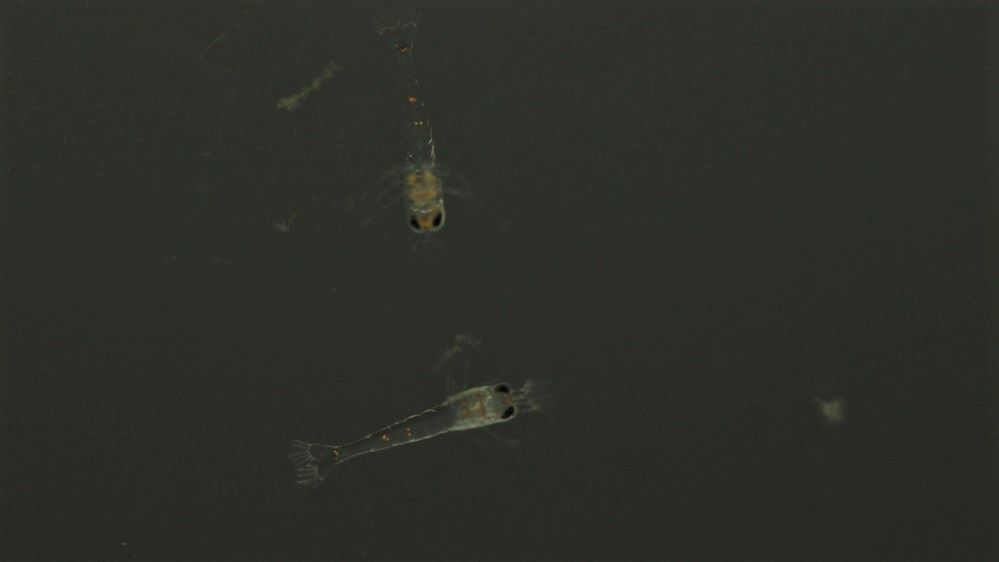
Basic Brackish Water Tank Setup for Amano Shrimp Larvae
Creating the perfect environment for Amano shrimp larvae involves setting up a brackish water tank that caters to their unique needs. This isn’t just about filling a tank with water and adding salt; it’s about creating a habitat that supports their growth and development.
Start with selecting an appropriate tank. A 10-gallon tank often serves as a good nursery for the larvae, providing ample space without being too overwhelming to manage. Equip the tank with a gentle sponge filter . This type of filter not only ensures the water stays clean, but it also provides a surface for beneficial bacteria and biofilm to grow, serving as a natural food source for the larvae.
. This type of filter not only ensures the water stays clean, but it also provides a surface for beneficial bacteria and biofilm to grow, serving as a natural food source for the larvae.
The next step is to create the brackish conditions. This is done by adding marine salt to the tank, aiming for a specific gravity between 1.012 and 1.020. A refractometer can be a handy tool for this task. It’s important to remember that the salt used should be marine salt, not table salt or aquarium salt.
Temperature control is another crucial aspect. Amano shrimp larvae thrive in temperatures between 24-28°C (75-82°F). Depending on your local climate, you might need a heater to maintain this temperature range consistently.
to maintain this temperature range consistently.
Now, let’s talk about cycling the tank. A quick way to cycle a small tank is to use a sponge filter from one of your established freshwater tanks. This filter already hosts beneficial bacteria, algae, and detritus, which will kickstart the cycling process in the new tank.
To further boost the cycling process, you can use a product like Seachem Stability, which contains a type of bacteria suitable for brackish water. The bacteria, algae, and detritus on the filter will break down and provide a food source for the Seachem bacteria.
Given that brackish water has a good general hardness (GH) and carbonate hardness (KH), you don’t have to worry about pH swings. And since Amano shrimp larvae are so small, they don’t contribute significantly to the bioload of the tank.
After setting up the tank, give it 1-2 weeks to cycle. Test the water for ammonia; if there’s none, it’s a good sign that the tank is ready for the larvae. Remember, the longer the cycling process, the better, if possible.

Feeding Amano Shrimp Larvae
Nourishing Amano shrimp larvae requires a thoughtful approach, as their dietary needs are quite specific. In their initial stages, Amano shrimp larvae are predominantly planktonic feeders, meaning they feast on minuscule organisms suspended in the water.
In their natural habitat, they would consume a diverse diet of microscopic organisms, including algae, bacteria, and tiny invertebrates. In a home aquarium, we can emulate this diet by offering them a blend of specially prepared shrimp foods and live foods.
One of the most effective foods for Amano shrimp larvae is powdered goldfish flakes. These flakes are readily available and easy to add to the water. The larvae will then consume the goldfish flakes as they float in the water, providing them with essential nutrients for their growth and development.
Another commonly recommended food for Amano shrimp larvae is spirulina, a type of algae. Available in powdered form, spirulina can be effortlessly added to the water, providing another source of nutrition for the larvae.
When it comes to feeding the larvae, moderation is key. Overfeeding can lead to water contamination and poor water quality, which can be detrimental to the larvae. Instead of one large feeding, it’s more beneficial to provide small amounts of food multiple times a day. This approach ensures the larvae have a steady supply of food without compromising the water quality.
Write in detail about Culturing Green Water for Amano Shrimp Larvae Feeding
Culturing green water, or phytoplankton, can be an excellent way to provide a natural and nutritious food source for Amano shrimp larvae. Phytoplankton is a type of microscopic algae that floats in the water column, and it’s a primary food source for many aquatic organisms, including shrimp larvae.
To culture green water at home, you’ll need a clear container, dechlorinated water, a source of light, and a starter culture of phytoplankton. The process is relatively simple:
- Fill the container with dechlorinated water. You can use tap water, but make sure to treat it with a dechlorinator
 first to remove any harmful chemicals.
first to remove any harmful chemicals. - Add your starter culture of phytoplankton. You can purchase starter cultures online or from a local aquarium store.
- Place the container in a location where it will receive plenty of light, but not direct sunlight. Phytoplankton needs light to photosynthesize and grow, but too much direct sunlight can cause the water to overheat and kill the phytoplankton.
- Stir or shake the container daily to ensure the phytoplankton is well distributed throughout the water.
- Within a week or two, the water should start to turn a greenish color. This is a sign that the phytoplankton is growing and multiplying.
- Once the water is green, you can start to use it to feed your Amano shrimp larvae. Simply add a small amount of the green water to the larvae’s tank each day.
Culturing green water is a cost-effective and sustainable way to provide a high-quality food source for Amano shrimp larvae. Plus, it’s a fascinating process that can add another layer of interest to your shrimp-keeping hobby.
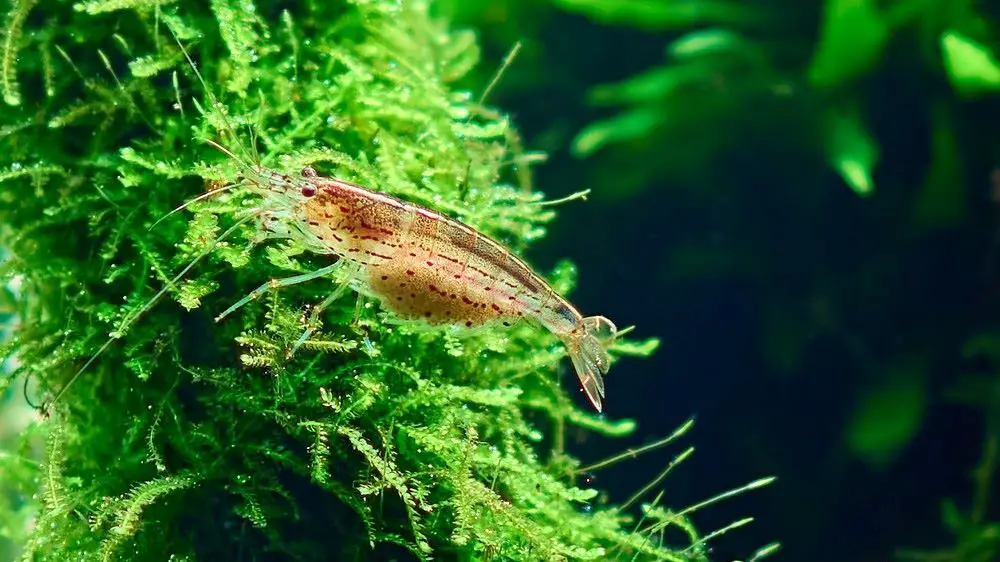
Acclimating Amano Shrimp Back to Freshwater
Transitioning Amano shrimp larvae from brackish water back to freshwater is a critical step in their life cycle. This process needs to be done carefully to avoid shocking the young shrimp with a sudden change in salinity. The recommended method for this is drip acclimation, a slow and steady process that gradually adjusts the shrimp to their new water conditions.
Drip acclimation involves setting up a slow drip of freshwater into the brackish water where the larvae are housed. This can be achieved using airline tubing with a knot tied to control the drip rate, or a commercial drip acclimation kit. The goal is to have a slow drip of about one drop per second.
The salinity will gradually decrease as the freshwater drips into the brackish water. This slow change gives the shrimp larvae time to adjust to the new conditions, reducing the risk of shock. The water volume will increase during this process, so make sure your container is large enough to accommodate this.
The acclimation process should be done over a long period, ideally over several days. The longer the acclimation period, the better for the shrimp. This gives them plenty of time to adjust to the changing conditions and reduces stress.
Once the salinity of the water matches that of the freshwater tank, the shrimp larvae can be gently transferred to their new home. It’s essential to closely monitor the shrimp during this transition period to ensure they adjust well to the freshwater conditions.
Conclusion
Breeding Amano shrimp is a challenging journey, but the rewards make it all worthwhile. From understanding their unique life cycle to providing the right conditions for their survival, each step brings its own set of challenges and joys. But with patience, dedication, and a keen eye for detail, you can successfully breed these fascinating creatures in your own home aquarium.
Remember, the key to successful Amano shrimp breeding lies in understanding their needs at each life cycle stage. Provide a balanced diet, maintain optimal water conditions, and be patient. The process may be long, but the sight of your home-bred Amano shrimp thriving in your tank will be well worth the wait.
If you ever need help or advice along the way, please don’t hesitate to reach out. The shrimp keeping community is a supportive and knowledgeable one, and there’s always someone ready to lend a hand or share their experiences.
Happy Amano Shrimp Keeping!
FAQ: All About Breeding Amano Shrimp
Q. Are Amano shrimp easy to breed?
A. Breeding Amano shrimp is considered challenging due to their unique life cycle. Unlike many freshwater shrimp, Amano shrimp larvae require brackish water to survive, which adds complexity to the breeding process.
Q. Is it possible for Amano shrimp to breed in freshwater?
A. While Amano shrimp can mate and lay eggs in freshwater, their larvae require brackish water to survive and develop. Therefore, successful breeding requires a transition from freshwater to brackish conditions.
Q. Do Amano shrimp breed in captivity?
A. Yes, Amano shrimp can breed in captivity, but it requires careful management of their diet, water conditions, and specific needs at each stage of their life cycle.
Q. What are the stages of Amano shrimp breeding?
A. The stages of Amano shrimp breeding include mating, egg carrying and hatching, larval development in brackish water, and metamorphosis into adult shrimp.
Q. How many babies do Amano shrimp have when pregnant?
A. A pregnant Amano shrimp can carry anywhere from a few hundred to a thousand eggs. However, the survival rate of the larvae can be quite low.
Q. Will Amano shrimp breed with blue shrimp?
A. No, Amano shrimp will not breed with blue shrimp (typically a type of Neocaridina) as they are different species with different breeding requirements.
Q. What is the easiest shrimp to breed?
A. Neocaridina shrimp, such as the Cherry shrimp, are often considered the easiest to breed as their offspring are miniature versions of the adults and do not require brackish water.
Q. Will Amano shrimp breed with Neocaridina?
A. No, Amano shrimp and Neocaridina shrimp are different species and will not interbreed.
Q. How many Amano shrimp per Litre?
A. A general guideline is to keep 2-3 Amano shrimp per 10 liters of water. This ensures they have enough space and resources to thrive.
Q. How long do Amano shrimps live?
A. Amano shrimp typically live for 2-3 years in well-maintained aquarium conditions. Their lifespan can be influenced by factors such as diet, water quality, and stress levels.
Resources and references for further reading on Amano shrimp:
- Amano Shrimp: Detailed Guide and Care: This guide from Fishkeeping World provides a comprehensive overview of Amano shrimp care, diet, breeding, and more.
- Amano Shrimp Information: Aquarium Source’s article offers detailed information on Amano shrimp, including their behavior, diet, and tank setup.
- Amano Shrimp Care Guide: The Shrimp Farm’s care guide covers everything you need to know about keeping Amano shrimp, from tank conditions to breeding.
- Breeding Amano Shrimp: This article from Aquarium Info provides a detailed guide on breeding Amano shrimp, including the unique challenges involved and how to overcome them.
- Amano Shrimp Breeding Journal: This forum thread on Planted Tank documents one user’s journey in breeding Amano shrimp, providing real-life insights and experiences.
- Amano Shrimp – Caridina multidentata: Seriously Fish’s species profile provides scientific information on Amano shrimp, including their habitat, size, and behavior.
These resources should provide a wealth of additional information for anyone interested in keeping and breeding Amano shrimp.
